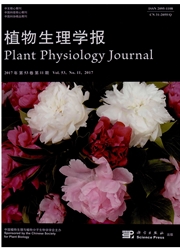

 中文摘要:
中文摘要:
本文以多穗型品种‘豫麦49-198’(YM49-198)和大穗型品种‘周麦16’(ZM16)为试验材料,采用裂区试验,研究了在施氮量为0、180、360 kg·hm^-2和播种量为75、150、225、300 kg·hm^-2条件下对冬小麦干物质累积、转运、分配及产量的影响。结果表明:施氮量和播种量对小麦干物质累积量影响显著,增加施氮量或播种量均有利于小麦干物质累积量的升高,播种量对干物质累积的影响大于施氮量,多穗型品种YM49-198各生育时期干物质累积量均高于大穗型品种ZM16。在最低播种量75 kg·hm^-2下,花前干物质转运量、转运率及对籽粒的贡献率显著高于其他播种量处理;在播种量为150、225和300 kg·hm^-2的小麦花后光合同化量、对籽粒的贡献率均高于花前干物质转运量和贡献率,且均随播种量的增加而降低。施氮量和播种量对产量及构成要素的影响均达显著水平。综合考虑经济效益,为达到9 000 kg·hm^-2产量水平,YM49-498和ZM16的优化施氮量为180~220 kg·hm^-2,播种量分别为150~192和213~225 kg·hm^-2。
 英文摘要:
英文摘要:
Two winter wheat(Triticum aestivum) cultivars ‘Yumai 49-198'(multi-spike) and ‘Zhoumai 16'(large-spike type) were used to investigate the effects of nitrogen level and seeding rate on dry matter accumulation, translocation and grain yield in two genotypes of winter wheat, and find a balance between nitrogen level and seeding rate for high yield and high efficiency in wheat. The experiment was established as a split-plot design of three nitrogen levels(0, 180, 360 kg·hm^-2) and four seeding rates(75, 150, 225, 300 kg·hm^-2). The main results showed that the nitrogen level and seeding rate had significant effect on the dry matter accumulation of wheat, and the increase of nitrogen level or seeding rate was beneficial to the dry matter accumulation in wheat. Moreover, the effect of seeding rate was significantly greater than that of nitrogen. The dry matter accumulation of the multi-spike type cultivar YM49-198 was higher than that of large-spike cultivar ZM16 at each growth stage. At the lowest seeding rate of 75 kg·hm^-2, the dry matter translocation, translocation rate and the contribution rate to grain before anthesis was significantly higher than those of other seeding rate. The translocation of dry matter and its contribution to grain after anthesis were greater than those before anthesis at seeding rates of 150, 225, 300 kg·hm^-2, and both increased with seeding rate decreased. The results showed that the nitrogen level and sowing rate affected the yield and components significantly. Considering the economic benefits, in order to reach the 9 000 kg·hm^-2 yield level, the optimum nitrogen amount was 180–220 kg·hm^-2, and the seeding rate of YM49-498 and ZM16 was 150–192 and 213–225 kg·hm^-2, respectively.
 同期刊论文项目
同期刊论文项目
 同项目期刊论文
同项目期刊论文
 期刊信息
期刊信息
